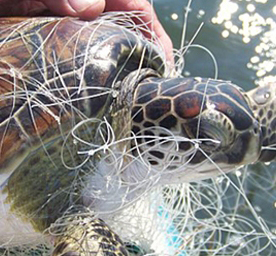
Too many sea turtles found in nets in upper Core Sound, lower Pamlico Sound
The N.C. Division of Marine Fisheries has been forced to close another large area of inshore waters to large-mesh gill nets because of interaction with sea turtles.
Last week, NCDMF closed waters from the NC 58 bridge at Cape Carteret south to the South Carolina state line; Beginning today, the upper Core Sound and Pamlico Sound south of Croatan and Roanoke sounds will be closed to the same large-mesh gill nets.
The proclamation to close the two sounds is directly tied to multiple interactions with sea turtles in the gill-net fishery. Since late May, the NCDMF’s Observer Program has reported eight sea turtle interactions in the area, including two dead green sea turtles, three live green sea turtles, one live loggerhead sea turtle, one live hybrid sea turtle (loggerhead-Kemp’s ridley) and one live sea turtle that was not identified before it freed itself from the gill net in which it was entangled. To make matters worse, one of the dead green sea turtles was in a large-mesh gill net set earlier than to one hour before sunset, which is a violation of state fishing regulations.
Large mesh gill nets are classified as gill nets with a closed mesh measurement of 4 to 6 ½ inches, which. These are primarily used as flounder nets in this area. Using large-mesh gill nets is subject to regulations included in a lawsuit- settlement agreement between the NCDMF and the Karen Beasley Sea Turtle Rescue and Rehabilitation Center.
Sea turtles are classified as endangered and threatened by the Endangered Species Act (ESA). However, there are provisions in section 10 of the ESA to allow limited incidental takes of listed species encountered in an otherwise lawful activity.
In the past, NCDMF had an Incidental Take Permit (ITP) for sea turtles in part of Pamlico Sound. It expired several years ago, and NCDMF began seeking an ITP for sea turtles in all internal coastal waters. The new ITP is nearing completion and its Environmental Assessment is currently posted on the Federal Register at https://www.federalregister.gov/articles/2013/07/16/2013-17037/notice-of-availability-of-draft-environmental-assessment-on-the-effects-of-issuing-an-incidental for review and public comment through July 31.
This closure will remain in place until at least Sept. 1. If sea turtle activity is still high, the season will remain closed. The flounder gill-net season is scheduled to open Sept. 1 in the Pamlico Sound Restricted Gill Net Area. Chris Batsavage, NCDMF’s Protected Resources Section Chief, has said that the season will not open if the ITP has not been issued.
This closure does not apply to run-around, strike, or drop nets that are used to surround a school of fish and are immediately retrieved.




Be the first to comment